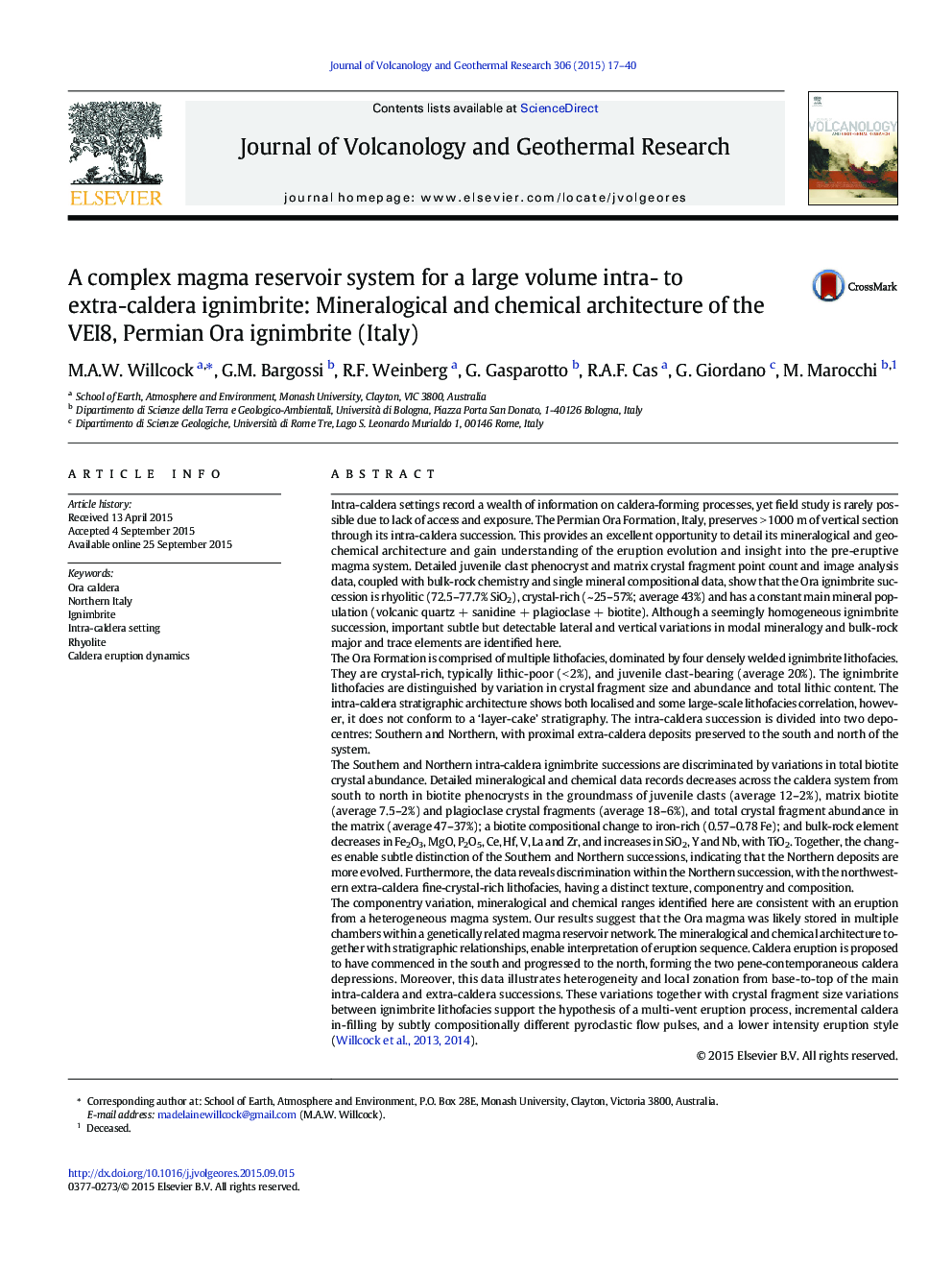| کد مقاله | کد نشریه | سال انتشار | مقاله انگلیسی | نسخه تمام متن |
|---|---|---|---|---|
| 4714375 | 1638316 | 2015 | 24 صفحه PDF | دانلود رایگان |

• The componentry and compositional ranges reveal an architecture in the intra-caldera deposit.
• The lateral compositional variations give insight into the pre-eruptive and eruption processes.
• Cross-section through the intra-caldera stratigraphy preserved
Intra-caldera settings record a wealth of information on caldera-forming processes, yet field study is rarely possible due to lack of access and exposure. The Permian Ora Formation, Italy, preserves > 1000 m of vertical section through its intra-caldera succession. This provides an excellent opportunity to detail its mineralogical and geochemical architecture and gain understanding of the eruption evolution and insight into the pre-eruptive magma system. Detailed juvenile clast phenocryst and matrix crystal fragment point count and image analysis data, coupled with bulk-rock chemistry and single mineral compositional data, show that the Ora ignimbrite succession is rhyolitic (72.5–77.7% SiO2), crystal-rich (~ 25–57%; average 43%) and has a constant main mineral population (volcanic quartz + sanidine + plagioclase + biotite). Although a seemingly homogeneous ignimbrite succession, important subtle but detectable lateral and vertical variations in modal mineralogy and bulk-rock major and trace elements are identified here.The Ora Formation is comprised of multiple lithofacies, dominated by four densely welded ignimbrite lithofacies. They are crystal-rich, typically lithic-poor (< 2%), and juvenile clast-bearing (average 20%). The ignimbrite lithofacies are distinguished by variation in crystal fragment size and abundance and total lithic content. The intra-caldera stratigraphic architecture shows both localised and some large-scale lithofacies correlation, however, it does not conform to a ‘layer-cake’ stratigraphy. The intra-caldera succession is divided into two depo-centres: Southern and Northern, with proximal extra-caldera deposits preserved to the south and north of the system.The Southern and Northern intra-caldera ignimbrite successions are discriminated by variations in total biotite crystal abundance. Detailed mineralogical and chemical data records decreases across the caldera system from south to north in biotite phenocrysts in the groundmass of juvenile clasts (average 12–2%), matrix biotite (average 7.5–2%) and plagioclase crystal fragments (average 18–6%), and total crystal fragment abundance in the matrix (average 47–37%); a biotite compositional change to iron-rich (0.57–0.78 Fe); and bulk-rock element decreases in Fe2O3, MgO, P2O5, Ce, Hf, V, La and Zr, and increases in SiO2, Y and Nb, with TiO2. Together, the changes enable subtle distinction of the Southern and Northern successions, indicating that the Northern deposits are more evolved. Furthermore, the data reveals discrimination within the Northern succession, with the northwestern extra-caldera fine-crystal-rich lithofacies, having a distinct texture, componentry and composition.The componentry variation, mineralogical and chemical ranges identified here are consistent with an eruption from a heterogeneous magma system. Our results suggest that the Ora magma was likely stored in multiple chambers within a genetically related magma reservoir network. The mineralogical and chemical architecture together with stratigraphic relationships, enable interpretation of eruption sequence. Caldera eruption is proposed to have commenced in the south and progressed to the north, forming the two pene-contemporaneous caldera depressions. Moreover, this data illustrates heterogeneity and local zonation from base-to-top of the main intra-caldera and extra-caldera successions. These variations together with crystal fragment size variations between ignimbrite lithofacies support the hypothesis of a multi-vent eruption process, incremental caldera in-filling by subtly compositionally different pyroclastic flow pulses, and a lower intensity eruption style (Willcock et al., 2013 and Willcock et al., 2014).
Journal: Journal of Volcanology and Geothermal Research - Volume 306, 15 November 2015, Pages 17–40